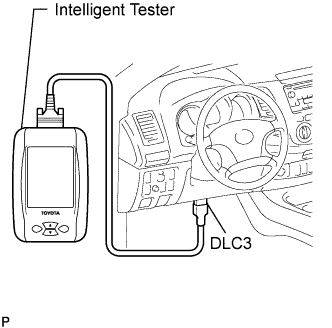Fuel System -- On-Vehicle Inspection |
| 1. CHECK FOR FUEL PUMP OPERATION AND FUEL LEAKS |
Connect the intelligent tester to the DLC3.
Turn the ignition switch ON.
- NOTICE:
- Do not start the engine.
Push the intelligent tester main switch ON.
Select the Active Test and enter the following menus: Powertrain / Engine and ECT / Active Test / Control the Fuel Pump / Speed.
 |
Check the fuel pump operation.
Check for pressure in the fuel inlet tube from the fuel line. Check that the sound of fuel flowing in the fuel tank can be heard.
If there is no sound, check the integration relay, fuel pump, ECM and wiring connector.
Check for fuel leaks.
Check that there are no fuel leaks after performing maintenance anywhere on the system.
If there are fuel leaks, repair or replace parts as necessary.
| 2. CHECK FUEL PRESSURE |
Check that the battery positive voltage is above 12 V.
Discharge the fuel system pressure (Toyota Fortuner RM000000YL4009X.html).
Disconnect the cable from the negative (-) battery terminal.
- CAUTION:
- Wait at least 90 seconds after disconnecting the cable from the negative (-) battery terminal to prevent airbag activation.
Pinch and pull the No. 1 fuel hose (fuel tube connector) to disconnect it from the fuel filter.
- CAUTION:
- Always follow the precautions (Toyota Fortuner RM000000YL4009X.html) before disconnecting the fuel tube connector (quick type).
- The fuel tube may spray fuel as a result of pressure that remains in it. Do not allow fuel to be sprayed in the engine compartment.
 |
Install SST (pressure gauge) as shown in the illustration.
- SST
- 09268-41048(90467-13001,95336-08070,09268-41500,09268-41120)
09268-45014(09268-41200,09268-41220)
 |
Wipe off any gasoline.
Reconnect the cable to the negative (-) battery terminal.
Operate the fuel pump.
Connect the intelligent tester to the DLC3.
Turn the ignition switch ON.
- NOTICE:
- Do not start the engine.
Push the intelligent tester main switch ON.
Select the Active Test and enter the following menus: Powertrain / Engine and ECT / Active Test / Control the Fuel Pump / Speed.
Measure the fuel pressure.
- Standard fuel pressure:
- 281 to 287 kPa (2.87 to 2.93 kgf/cm2, 40.8 to 41.7 psi)
If the pressure is lower than the specification, check the fuel hoses and connections, fuel pump, fuel filter and fuel pressure regulator.
Start the engine.
Measure the fuel pressure.
- Standard fuel pressure:
- 281 to 287 kPa (2.87 to 2.93 kgf/cm2, 40.8 to 41.7 psi)
Stop the engine.
Check that the fuel pressure remains as specified for 5 minutes after the engine has stopped.
- Standard fuel pressure:
- 147 kPa (1.5 kgf/cm2, 21 psi) or more
After checking the fuel pressure, disconnect the cable to the negative (-) battery terminal and carefully remove SST and the fuel tube connector to prevent gasoline from spraying.
Reconnect the No. 1 fuel hose (fuel tube connector).
| 3. INSPECT FOR FUEL LEAK |
Check that there are no fuel leaks after performing maintenance anywhere on the fuel system.
If there are fuel leaks, repair or replace parts as necessary.